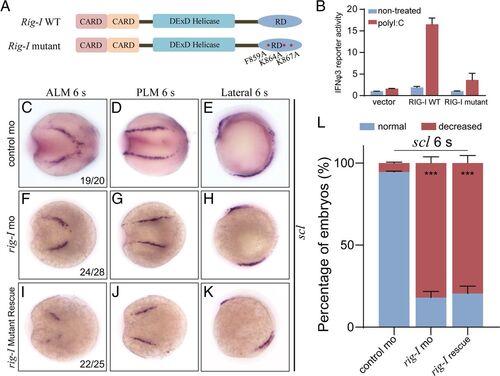Fig. 8
|
RNA-binding–deficient RIG-I mutant is unable to rescue the defect of hematopoietic precursors in rig-I morphants (A) Schematic of various forms of RIG-I, including wild-type and RNA-binding–deficient mutant RIG-Is with amino acid substitutions at F859, K864, and K867 sites in the repressor domain (RD), as indicated by asterisks. (B) A luciferase assay was performed using epithelioma papulosum cyprini cells transfected with the IFNφ3-pro luciferase reporter and TK-Renilla together with 20 ng of RIG-I wild-type or RIG-I mutant (F859A, K864A, K867A), followed by transfection with poly(I:C) (0.1 μg/ml) for another 24 h. (C−K) Expression of hematopoietic precursor marker scl/tal1 at the six-somite stage in embryos injected with control MO from dorsal view (C and D) and lateral view (E), rig-I MO from dorsal view (F and G) and lateral view (H), or rig-I MO and RNA-binding-deficient rig-I mutant mRNA from dorsal view (I and J) and lateral view (K). Images were captured under Olympus stereoscope (MVX10 MacroView; original magnification ×50). (L) Percent of embryos with phenotype of normal or decreased staining intensity in control or rig-I morphant embryos from (B)–(J) based on WISH analysis. The number of embryos used for statistics is shown in each figure. Each experiment was repeated three times (n = 3, mean ± SD, Student t test, ***p < 0.001). |
| Gene: | |
|---|---|
| Fish: | |
| Knockdown Reagent: | |
| Anatomical Terms: | |
| Stage: | 5-9 somites |
| Fish: | |
|---|---|
| Knockdown Reagent: | |
| Observed In: | |
| Stage: | 5-9 somites |

